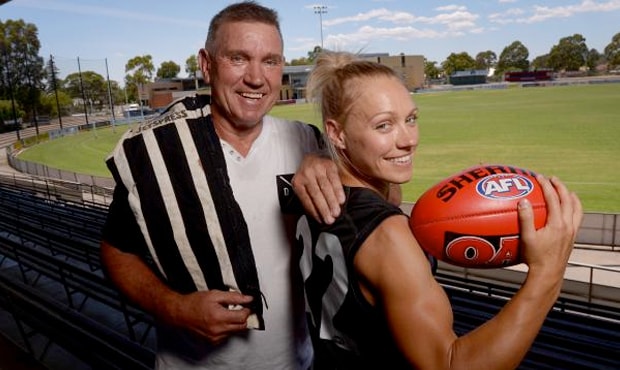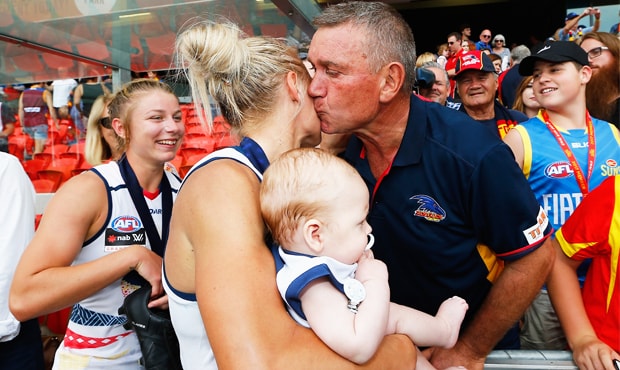It was the era of mullets and moustaches; a time when tight shorts and lace-up jumpers were the trends; and when footy expansion meant national, not international as it does today.
Remember the ‘80s?
If you can, you will recall it as one of the most volatile periods in Australian football history. It was a time of seismic change which dragged a near-broke Victorian Football League – with its 12 parochial clubs who played predominantly on suburban grounds each Saturday afternoon (often on muddy grounds) – towards the Australian Football League of today – when 18 clubs play in every state and territory at an assortment of times during the day and night (often under a roof).
If can’t recall them, you missed a remarkable decade for the game, and for Collingwood.
But don’t fret; Collingwood Forever plans to transport you back in time each week for a blast from the 1980s past, profiling a player who made an impact for one reason or another during that decade. They might not have all been stars, but each contributed to one of the club’s most tumultuous periods.
It's not how long you spend at a football club; it's what you do when you are there.
That adage sums up Greg Phillips' fleeting four-season contribution to Collingwood during the early-to-mid 1980’s, and while he played only 84 VFL games for the club, he made a lasting impact on the teammates around him, and supporters who remember him fondly.
Phillips was a hard-nosed, chunky, key-position defender who was always prepared to give his all, most notably when the Magpies’ back half was under siege. A big man on the field (almost 100 kilos) and a big personality within the playing group, he made his teammates walk taller when he was around them, and often left them smiling, such was his engaging personality.
His equal-third placing in the 1985 Copeland Trophy – behind Mark Williams and Shane Morwood – highlighted his value to the team. But he was also a binding force in fostering camaraderie within the playing group as a practical joker and likeable character. One of his former coaches called him a “larrikin” who was popular with all of those who worked with him.
The electrifying eighties: Glenn McFarlane sets the scene.
Phillips had been one of the key recruiting targets of the New Magpies, the reform group which seized power in late 1982, promising to embark on one of the biggest talent acquisitions in Australian football history. Some made a difference; most didn’t. The audacious spree would push the club to the brink of bankruptcy, as it spent millions on transfer fees, salaries and costs.
A South Australian, Phillips didn’t come cheap, either, but at least he proved an important player in his short time at Victoria Park.
Having established a reputation as one of the best centre half-backs outside the VFL in the early 1980s, Phillips originally came from the small South Australian town of Minnipa, where his family ran a sheep and grain farm. He moved to Port Lincoln, 250 kilometres away, for schooling and for football, a pathway that ultimately led him to Port Adelaide in the SANFL.
The move changed his life. He would say years later: “I've always wondered what would have happened if I hadn't played footy, I'd probably still be working in the abattoirs in Port Lincoln.”
Phillips played in a losing SANFL grand final in his debut year of 1976 – against Sturt, the team he followed as a kid. He went on to play in four premierships in his first five seasons (1977, '79, '80 and '81), impressing with his uncompromising attack on the ball and his ability to read the play.

Greg Phillips and his daughter, Erin. Picture: Keryn Stevens. Source:News Corp Australia
He was an All-Australian in 1980 and won the Fos Williams Medal for best afield in South Australia's clash with Western Australia at Subiaco in 1982.
Phillips planned to play out the last year of his contract with Port Adelaide before making a move to the VFL. But he opted to move when his Port coach John Cahill took on the senior job with Collingwood for the 1983 season, fast-tracking his move east.
"I always thought I'd beat John to Collingwood, but it ended up the other way around," Phillips told the Sun in 1990. "I'd already signed up; John wasn't really sure what he was doing.”
Cahill wanted his dependable defender alongside him at Victoria Park, and set a move in motion to get the 24-year-old to Victoria - sooner rather than later.
"I lobbed into Melbourne at the time Collingwood was looking for a defender," Cahill said. "And I mentioned Greg Phillips, who in my opinion was the best centre half-back in Australia. So (former star Magpie and then New Magpies board member) Len Thompson and I went over and saw him play a pre-season game and he was the best player on the ground."
Port Adelaide wanted to hold Phillips to the last year of his contract, and took Supreme Court action in an effort to thwart the transfer. In the end, the action was settled out of court, and Collingwood was forced to pay out a reported $300,000 to get their man.
Phillips took on the No. 3 jumper and played his first match against Carlton at Waverley in round three, 1983. He had 20 disposals and made an immediate impact, even if his first kick landed in the arms of Blue David Glascott.
Quickly, 'Flipper', as he became known, established himself as a no-fuss, no-frills, uncomplicated defender. He managed to keep his Port Adelaide nickname ‘Kutchie’ under wraps from his new teammates. The Port players called him that when he arrived at the club as a teenager, with ‘Kutchie’ derived from ‘Kutchie, Kutchie Coo’, given his youthful look at the time.
Cahill recalled his influence on the group at a time when it was aiming to bring together a host of new players from all parts of the country. “In match situations at Collingwood, Greg was always ‘there’,” he said. “You always knew that if the ball came down to defence, his body was in line with the ball."
"As a coach, I believe most players will accept a recruit if he hits the ball hard. If he commits his body, and risks personal injury, he is accepted much quicker than one that just sits around the edge a bit. And at Collingwood ... Greg went straight ahead."
His importance grew when Bill Picken left for Sydney at the end of the season 1983, a debut year in which Phillips played 20 games.
One description of Phillips at the time said: "He marks well, knocks, blocks and uses his bulk to advantage. He is an exceptional reader of the ball and keeps cool under pressure situations.”
He was sometimes critiqued for his lack of pace, though one of his former Port Adelaide teammates, Stephen Clifford (who played at Collingwood before Phillips moved across) said: "From the sidelines, it looks as if he's slow because of his build. But, believe me; he is quicker than he looks."

Greg Phillips and his daughter, Erin, celebrate Adelaide's AFL Women's premiership success in 2017.
Phillips quickly became one of the most popular clubmen of the time. He didn't mind a drink or a chat; he was apart-owner in a racehorse called Magpies’ Hope with Tony Shaw and Darren Millane; and was renowned as a practical joker in the rooms.
"As a bloke he is blessed with a contagious personality and a leadership quality which came through at Collingwood,” Cahill said. “Quite honestly, Greg is the sort of guy who is a must around any football club and blokes like him are few and far between."
He was a member of Collingwood's 1984 finals series, playing 22 games that season, and had his best season the following year when running third in the best-and-fairest count.
Phillips only planned to stay at Collingwood for three seasons before returning to Adelaide with his young family. However, he loved it so much – even though Cahill left at the end of 1984 – that he played on until the end of 1986. It proved a tough year for the club on and off the field.
Bob Rose handed over the reins to Leigh Matthews as coach after three rounds and Collingwood's financial meltdown meant the players had to take a 20 per cent pay cut to help keep the doors open. Phillips had no issue taking a pay-cut and also appeared in television and newspaper advertisements for the club, featuring stars such as Tony Shaw, Mark Williams and David Cloke.
His 84th and last VFL game came in the final round of 1986, and one of his last acts as a Collingwood player was attending the 1986 Brownlow Medal, where he polled a career-high six votes.
Collingwood Forever profile: Greg Phillips.
Phillips never got to taste the ultimate success at Collingwood, but on his return to Port Adelaide, he went on to play another seven seasons for four more flags (eight in total) in the SANFL. He contemplated joining Adelaide when the Crows came into the AFL in 1991, but his loyalty to the SA Magpies won out.
He ended up playing 343 games with Port Adelaide, and if you add his 84 VFL games and his 20 state games, he carried his powerful frame through 437 senior games.
But his retirement at the end of 1993 didn’t end his family’s connection to the game. One of his daughters, Amy, married Shaun Burgoyne, who also made premierships an art form with Port Adelaide and Hawthorn, and another, Erin, not only represented Australia in basketball, and played so successfully in the WNBA, but has been one of the stars of the AFLW juggernaut.
When Erin and the Crows won the inaugural 2017 AFLW premiership, and she won the first AFLW MVP award, the typically understated Greg Phillips called it his greatest moment in football.


